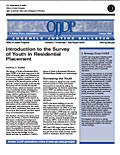
OJJDP sponsors the Nation's most comprehensive data collection program on juvenile offenders in custody and the facilities that hold them. Through a constellation of surveys—which include the Survey of Youth in Residential Placement (SYRP), the Census of Juveniles in Residential Placement (CJRP), and the Juvenile Residential Facility Census (JRFC)—the agency provides critical information to State and national researchers and policymakers who are investigating and seeking answers to major policy and practice questions affecting youth in residential placement, and disseminating those findings to the field. While CJRP and JRFC gather critical data from residential facility administrators, SYRP interviews juveniles, providing an unprecedented inside look at their experiences in custody. By directly questioning youth, SYRP addresses issues that no other information source covers.
This spring, OJJDP will officially release the results of SYRP interviews conducted in 2003. The results are expected to provide policymakers with a richly textured view of the family histories of juveniles in custody, how juveniles experience confinement, and how facility structure and operations may affect those experiences.
SYRP is the most recent addition to OJJDP's multitiered data-collection effort. SYRP targets offender youth ages 10–20 in facilities surveyed for CJRP and JRFC, drawing a nationally representative sample of more than 7,000 youth from this population. The survey addresses both pre- and postadjuducation youth and facilities. Using computer-assisted self-interviews, SYRP asks youth about their backgrounds, offense histories, and problems; the facility environment; their experiences in the facility; and their expectations for the future.
The SYRP interview data are limited to facility-level administrative data, including the structure, characteristics, capacity, security, and services of the facility. More than 200 facilities participated in SYRP.
The results identify a set of factors, each of which predicts a youth's risk of violence in the context of the other factors, detailing a broad set of characteristics, circumstances, and conditions that operate independently to elevate the risk of violence. These findings offer valuable guidance to the field because policy and practices can modify many of the strong risk factors.
Following is a preview of a few of the researchers' findings:
- Less than one-half of the juveniles surveyed had two parents taking care of them when they were growing up. Forty-two percent had one parent taking care of them, and 11 percent had no parent.
- Twenty-two percent of males and 13 percent of females either have children or are expecting a child.
- Nineteen percent say they are a member of a gang in the facility, 75 percent say there are fights in their facility, and 32 percent have been personally involved in fights.
- Seventeen percent report that while in custody they have been beaten up and injured, their property was taken directly by force or threat, and/or they were forced to engage in sexual activity.
- Twenty percent have 2–9 roommates while in custody, and 17 percent have 10 or more roommates. Thirty-four percent often or always have difficulty falling asleep.
- Thirty-seven percent of the youth had either recent suicidal thoughts or feelings or a past suicide attempt. Fifty-three percent of youth in custody have seen a counselor in their current facility to discuss emotional problems.
- Thirty-five percent say staff use unnecessary force, and 59 percent experienced some form of coercive control (e.g., strip searched, put into handcuffs, sprayed with pepper spray).

Following the general structure of the survey design, other Bulletins describe research in each of the survey's topic areas:
- Survey of Youth in Residential Placement: Youth's Characteristics, Backgrounds, and Expectations summarizes current offenses and youth's previous involvement in the juvenile justice system, and provides data on offenders' family backgrounds.
- Survey of Youth in Residential Placement: Conditions of Confinement describes the physical features of juvenile facilities, rates the quality of available programs, and reports on the access to various social, emotional, and legal supports at the facilities.
- Survey of Youth in Residential Placement: Youth's Needs and Services They Receive in Custody includes questions about recent mental and emotional symptoms, experiences associated with emotional problems, and available treatment for such problems.
- Survey of Youth in Residential Placement: Nature and Risk of Victimization in Residential Placement provides information on the percentages of youth who report victimization experiences while in custody including theft, robbery, physical assault or threat, or sexual assault, and how these problems were addressed.
- Survey of Youth in Residential Placement: Highlights of the Survey of Youth in Residential Placement presents an overview and summary of the most important aspects of the information gleaned from the survey.
Release of the above Bulletins will be highlighted in future issues of News @ a Glance and JUVJUST.

